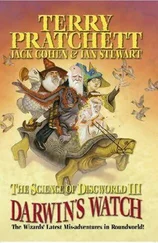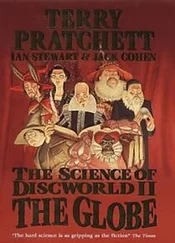Terry Pratchett - Science of Discworld
Здесь есть возможность читать онлайн «Terry Pratchett - Science of Discworld» весь текст электронной книги совершенно бесплатно (целиком полную версию без сокращений). В некоторых случаях можно слушать аудио, скачать через торрент в формате fb2 и присутствует краткое содержание. Жанр: Фантастика и фэнтези, на английском языке. Описание произведения, (предисловие) а так же отзывы посетителей доступны на портале библиотеки ЛибКат.
- Название:Science of Discworld
- Автор:
- Жанр:
- Год:неизвестен
- ISBN:нет данных
- Рейтинг книги:4 / 5. Голосов: 1
-
Избранное:Добавить в избранное
- Отзывы:
-
Ваша оценка:
- 80
- 1
- 2
- 3
- 4
- 5
Science of Discworld: краткое содержание, описание и аннотация
Предлагаем к чтению аннотацию, описание, краткое содержание или предисловие (зависит от того, что написал сам автор книги «Science of Discworld»). Если вы не нашли необходимую информацию о книге — напишите в комментариях, мы постараемся отыскать её.
Science of Discworld — читать онлайн бесплатно полную книгу (весь текст) целиком
Ниже представлен текст книги, разбитый по страницам. Система сохранения места последней прочитанной страницы, позволяет с удобством читать онлайн бесплатно книгу «Science of Discworld», без необходимости каждый раз заново искать на чём Вы остановились. Поставьте закладку, и сможете в любой момент перейти на страницу, на которой закончили чтение.
Интервал:
Закладка:
However, the more we pursue the implications of mathematical rules, the more flexible a rule-based universe begins to seem. Conversely, the more we understand biology, the more important its physical aspects become, because life isn't a special kind of matter, so it too must obey the rules of physics. What looked like a vast, unbridgeable gulf between the life sciences and the physical sciences is shrinking so fast that it's turning out to be little more than a thin line scratched in the sand of the scientific desert.
If we are to step across that line, though, we need to revise the way we think. It's all too easy to fall back on old, and inappropriate, habits. To illustrate the point, and to set up a running theme for this book, let's see what the engineering problems of getting to the Moon tell us about how living creatures work.
The main obstacle to getting a human being on to the Moon is not distance, but gravity. You could waIk to the Moon in about thirty years, given a path, air, and the usual appurtenances of the experienced traveller, were it not for the fact that it's uphill most of the way. It takes energy to lift a person from the surface of the planet to the neutral point where the Moon's pull cancels out the Earth's. Physics provides a definite lower limit for the energy you must expend, it's the difference between the 'potential energy' of a mass placed at the neutral point and the potential energy of the same mass placed on the ground. The Law of Conservation of Energy says that you can't do the job with less energy, however clever you are.
You can't beat physics.
This is what makes space exploration so expensive. It takes a lot of fuel to lift one person into space by rocket, and to make matters worse, you need more fuel to lift the rocket ... and more fuel to lift the fuel... and ... At any rate, it seems that we're stuck at the bottom of the Earth's gravity well, and the ticket out has to cost a fortune.
Are we, though?
At various times, similar calculations have been applied to living creatures, with bizarre results. It has been 'proved' that kangaroos can't jump, bees can't fly, and birds can't get enough energy from their food to power their search for the food in the first place. It has even been 'proved' that life is impossible because living systems become more and more ordered, whereas physics implies that all systems become more and more disordered. The main message that biologists have derived from these exercises has been a deep scepticism about the relevance of physics to biology, and a comfortable feeling of superiority, because life is clearly much more interesting than physics.
The correct message is very different: be careful what tacit assumptions you make when you do that kind of calculation. Take that kangaroo, for instance. You can work out how much energy a kangaroo uses when it makes a jump, count how many jumps it makes in a day, and deduce a lower limit on its daily energy requirements. During a jump, the kangaroo leaves the ground, rises, and drops back down again, so the calculation is just like that for a space rocket. Do the sums, and you find that the kangaroo's daily energy requirement is about ten times as big as anything it can get from its food. Conclusion: kangaroos can't jump. Since they can't jump, they can't find food, so they're all dead.
Strangely, Australia is positively teeming with kangaroos, who fortunately cannot do physics.
What's the mistake? The calculation models a kangaroo as if it were a sack of potatoes. Instead of a thousand kangaroo leaps per day (say), it works out the energy required to lift a sack of potatoes off the ground and drop it back down, 1000 times. But if you look at a slow-motion film of a kangaroo bounding across the Australian outback, it doesn't look like a sack of potatoes. A kangaroo bounces, lolloping along like a huge rubber spring. As its legs go up, its head and tail go down, storing energy in its muscles. Then, as the feet hit the ground, that energy is released to trigger the next leap. Because most of the energy is borrowed and paid back, the energy cost per leap is tiny.
Here's an association test for you. 'Sack of potatoes' is to 'kangaroo' as 'rocket' is to, what? One possible answer is a space elevator. In the October 1945 issue of Wireless World the science-fiction writer Arthur C. Clarke invented the concept of a geostationary orbit, now the basis of virtually all communications satellites. At a particular height, about 22,000 miles (35,000 km) above the ground, a satellite will go round the Earth exactly in synchrony with the Earth's rotation. So from the ground it will look as though the satellite isn't moving. This is useful for communications: you can point your satellite dish in a fixed direction and always get coherent, intelligent signals or, failing that, MTV.
Nearly thirty years later Clarke popularized a concept with far greater potential for technological change. Put up a satellite in geostationary orbit and drop a long cable down to the ground. It has to be an amazingly strong cable: we don't yet have the technology but 'carbon nanotubes' now being created in the laboratory come close. If you get the engineering right, you can build an elevator 22,000 miles high. The cost would be enormous, but you could then haul stuff into space just by pulling on the cable from above.
Ah, but you can't beat physics. The energy required would be exactly the same as if you used a rocket.
Of course. Just as the energy required to lift a kangaroo is exactly the same as that required to lift a sack of potatoes.
The trick is to find a way to borrow energy and pay it back. The point is that once the space elevator is in place, after a while there's just as much stuff coming down it as there is going up. Indeed, if you're mining the Moon or the asteroids for metals, there will soon be more stuff coming down than goes up. The materials going down provide the lifting energy for those going up. Unlike a rocket, which gets used up every time you fire it, a space elevator is self-sustaining.
Life is like a space elevator. What life self-sustains is not energy, but organization. Once you have a system that is so highly organized that it can reliably make copies of itself, that degree of organization is no longer 'expensive'. The initial investment may have been huge, as for a space elevator, but once the investment has been made, everything else is free.
If you want to understand biology, it is the physics of space elevators that you need, not the physics of rockets.
How can Discworld's magic illuminate Roundworld's science? Just as the gulf between the physical and biological sciences is turning out to be far narrower than we used to think, so the gulf between science and magic is also becoming smaller The more advanced our technologies become, the less possible it is for the everyday user to have any idea of how they work. As a result, they look more and more like magic. As Clarke realized, this tendency is inevitable; Gregory Benford went further and declared it desirable.
Technology works because whoever built it in the first place figured out enough of the rules of the universe to make the technology do what was required of it. You don't need to get the rules right to do this, just right enough, space rockets work fine even though their orbits are computed using Newton's stab at the rules of gravity, which aren't as accurate as Einstein's. But what you can accomplish is severely constrained by what the universe will permit. With magic, in contrast, things work because people want them to. You still have to find the right spell, but what drives the development is human wishes (and, of course, the knowledge, skill and experience of the practitioner). This is one reason why science often seems inhuman, because it looks at how the universe drives us, rather than the other way round.
Читать дальшеИнтервал:
Закладка:
Похожие книги на «Science of Discworld»
Представляем Вашему вниманию похожие книги на «Science of Discworld» списком для выбора. Мы отобрали схожую по названию и смыслу литературу в надежде предоставить читателям больше вариантов отыскать новые, интересные, ещё непрочитанные произведения.
Обсуждение, отзывы о книге «Science of Discworld» и просто собственные мнения читателей. Оставьте ваши комментарии, напишите, что Вы думаете о произведении, его смысле или главных героях. Укажите что конкретно понравилось, а что нет, и почему Вы так считаете.












